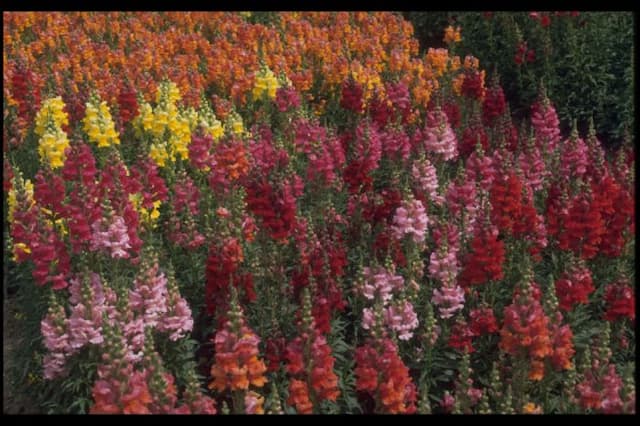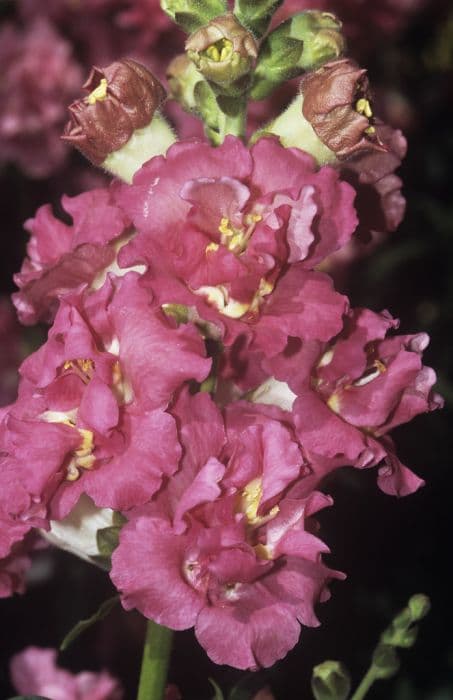Beardtongue Penstemon 'Chester Scarlet'

ABOUT
The 'Chester Scarlet' is a cultivar esteemed for its striking scarlet flowers. Its foliage is typically a rich green, providing a beautiful backdrop to the tubular blooms that are hallmark to this plant. Each flower showcases a flaring mouth, inviting a variety of pollinators. The leaves can often be lance-shaped, adding to the plant's aesthetic with their narrow and pointed form. This cultivar is part of a group known for their showy spike-like clusters of flowers that can be a magnet for hummingbirds and bees during their blooming season. The vibrant scarlet color of this variety makes it a standout in any garden setting, creating a bold splash of color that is hard to miss.
About this plant
 Names
NamesFamily
Plantaginaceae
Synonyms
Beardtongue, Chester Scarlet Penstemon
Common names
Penstemon 'Chester Scarlet'.
 Toxicity
ToxicityTo humans
Penstemon 'Chester Scarlet' is not commonly known to be toxic to humans. However, as with any plant, individuals may have varying sensitivities, and ingesting plant material could potentially cause mild stomach upset or an allergic reaction in sensitive individuals. These cases are not typical, and Penstemon species are generally considered safe around humans. If ingestion occurs and adverse reactions are noted, medical advice should be sought.
To pets
Penstemon 'Chester Scarlet' is not known to be toxic to pets. It is not listed among the common toxic plants that pose risks to dogs, cats, or other domestic animals. Ingestion of this plant by pets is unlikely to cause more than possibly mild gastrointestinal upset, if any symptoms at all. However, individual pets can have different reactions, and if you notice any sign of distress after your pet has ingested part of the plant, it's best to consult a veterinarian.
 Characteristics
CharacteristicsLife cycle
Perennials
Foliage type
Deciduous
Color of leaves
Green
Flower color
Scarlet
Height
2-3 feet (0.6-0.9 meters)
Spread
1-2 feet (0.3-0.6 meters)
Plant type
Herb
Hardiness zones
3-8
Native area
North America
Benefits
 General Benefits
General Benefits- Attracts Pollinators: Penstemon 'Chester Scarlet', commonly known as Beardtongue, is known for attracting bees, butterflies, and hummingbirds, thereby supporting pollination.
- Drought Tolerant: Beardtongue plants are well-adapted to dry conditions, making them great for water-wise gardening and areas prone to drought.
- Low Maintenance: Beardtongue requires minimal care once established, making them ideal for gardeners seeking plants that don't require constant attention.
- Colorful Blooms: The 'Chester Scarlet' variety is prized for its vibrant scarlet flowers which add visual interest and color to garden landscapes.
- Deer and Rabbit Resistant: These plants are generally resistant to browsing by deer and rabbits, which can be beneficial in areas where wildlife can be a problem for gardens.
 Medical Properties
Medical PropertiesThis plant is not used for medical purposes.
 Air-purifying Qualities
Air-purifying QualitiesThis plant is not specifically known for air purifying qualities.
 Other Uses
Other Uses- Penstemon 'Chester Scarlet' can be used to make a natural dye; the flowers may produce subtle shades of pink or purple.
- The tubular flowers can serve as educational tools for biology classes studying the structure of flowers and pollination strategies.
- Parts of the plant, like stems, can be utilized in crafting activities such as making miniature wreaths for dolls or fairy gardens.
- It's visually stimulating for pet enclosures like aviaries, attracting birds that might feed on the nectar while adding a splash of color to the environment.
- In an office setting, Penstemon can be used to create a calming, nature-inspired decor theme for improving mental wellbeing.
- Floral photography enthusiasts can use Penstemon as a subject to practice macro photography skills, capturing detailed images of its flowers and foliage.
- Penstemon can be used in table settings for events, where the flowers are placed in small vases or incorporated into natural table runners.
- Enthusiasts of pressed-flower art can add the bright flowers to their artwork, creating colorful and vivid designs in bookmarks, cards, or framed pieces.
- Used in floating flower displays, Penstemon flowers can be floated in bowls of water as part of table centerpieces or decorative accents.
- Create a theme garden based on color schemes featuring Penstemon ‘Chester Scarlet’ as the central plant, surrounded by other flora offering contrasting hues.
Interesting Facts
 Feng Shui
Feng ShuiThe Beardtongue is not used in Feng Shui practice.
 Zodiac Sign Compitability
Zodiac Sign CompitabilityThe Beardtongue is not used in astrology practice.
 Plant Symbolism
Plant Symbolism- Boldness and Confidence: The vibrant scarlet color of the Penstemon 'Chester Scarlet', commonly known as Beardtongue, often symbolizes boldness and confidence. Its striking appearance could be interpreted as a sign of standing out and being audacious in life.
- Stability and Strength: Beardtongue has a sturdy structure that can withstand various conditions, which might be seen as a representation of strength and stability in the face of adversity.
- Diversity and Adaptability: Penstemons are known for their wide variety and ability to adapt to different environments. The 'Chester Scarlet' variety could imply the importance of embracing diversity and being adaptable to change.
 Water
WaterBeardtongue should be watered deeply but infrequently, as it prefers well-drained soil and is quite drought-tolerant once established. During the growing season, watering once a week with approximately 1 inch of water should suffice, but be ready to adjust this frequency based on rainfall and temperature conditions. During hot, dry periods, you might need to water twice a week. Make sure not to overwater, as standing water or soggy conditions can lead to root rot. Throughout winter, watering can usually be reduced unless the climate is extremely dry. It's best to water in the morning to allow excess moisture on the foliage to evaporate during the day.
 Light
LightBeardtongue thrives when planted in a location with full sun, meaning it should receive at least 6 to 8 hours of direct sunlight per day. It can also tolerate partial shade, especially in hot climates where it may benefit from some relief from the intense afternoon sun. However, too much shade can lead to leggy growth and fewer flowers, so aim for the sunniest spot in your garden for optimal flowering.
 Temperature
TemperatureBeardtongue is quite tolerant of a wide range of temperatures but grows best when the temperature is between 60 to 75 degrees Fahrenheit. It can survive temperatures as low as 10 degrees Fahrenheit without damage and can tolerate high temperatures well if adequate moisture is available. To promote the best growth and flowering, providing consistent temperatures within the ideal range is beneficial, though the plant is adaptable to typical outdoor variations.
 Pruning
PruningPruning beardtongue encourages a bushier plant with more flowers and prevents it from becoming too leggy. Deadheading spent flowers will promote continuous blooming throughout the season. After the first killing frost, you can cut back the entire plant to ground level, as this perennial will re-emerge in spring. Pruning can be done anytime flowering has ceased or the plant appears overgrown, usually in late fall.
 Cleaning
CleaningAs needed
 Soil
SoilBeardtongue prefers well-draining soil that is rich in organic matter with a pH range from slightly acidic to neutral (pH 6.0-7.0). A mix containing loamy garden soil, compost, and coarse sand would be ideal to ensure good drainage and fertility.
 Repotting
RepottingBeardtongue, being a perennial, doesn't need frequent repotting and is usually repotted only when it outgrows its current container, which is typically every 2-3 years.
 Humidity & Misting
Humidity & MistingBeardtongue thrives in average to low humidity conditions and does not require high humidity levels to grow well.
 Suitable locations
Suitable locationsIndoor
Ensure bright light and good air circulation.
Outdoor
Plant in sunny spot with well-draining soil.
Hardiness zone
4-9 USDA.
 Life cycle
Life cycleThe life cycle of Penstemon 'Chester Scarlet', also known as Beardtongue, begins with seed germination, typically in late winter to early spring when soil temperatures warm up. The seeds develop into seedlings, which establish a basic root system before sending up their first shoots. As spring progresses, the plant enters the vegetative stage, producing sturdy stems and lance-shaped leaves while becoming more robust. By early to mid-summer, the plant reaches the flowering stage, showcasing vivid scarlet, tubular flowers that attract hummingbirds and pollinators. After pollination, the flowers fade, and the plant produces capsules containing tiny seeds by late summer or fall, completing the reproductive cycle. Throughout the autumn, Beardtongue plants gradually enter dormancy, enduring the winter to begin the cycle anew the following season.
 Propogation
PropogationPropogation time
Spring-Early Summer
The most popular method for propagating Penstemon 'Chester Scarlet', commonly known as Beardtongue, involves the use of stem cuttings. This is typically done in late spring or early summer when the plant is actively growing. To propagate, select a healthy, non-flowering stem and cut a section that is about 4 to 6 inches (approximately 10 to 15 cm) long, making sure each cutting has at least a few leaves. Dip the cut end into a rooting hormone to encourage root development and then insert it into a well-draining potting mix. Make sure the leaves remain above the soil surface. The cutting should be kept moist but not wet, and placed in a bright, indirect light setting where it can establish roots over several weeks. Once the cutting has rooted and shows new growth, it can be transplanted to a more permanent location.





![Snapdragon [Pretty in Pink]](/_next/image?url=https%3A%2F%2Fplants-admin.emdemapps.com%2Fimages%2Fplants%2F%2Fimages%2F604b5cb3b5385.png&w=640&q=75)



